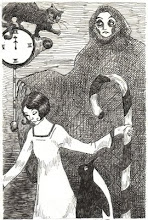I'm beginning to feel that I just don't get Steven Soderbergh unless he's in Hollywood mode. I watched his 2009 film,
The Girlfriend Experience staring porn star Sasha Grey last night and thought it was dreadful. I was going to couch my feelings in less blunt terms, but I think I'm running a fever, so screw it.
I'm really not sure what Soderbergh is trying to say with this film. It is set (and was likely filmed) during the economic collapse in 2008 during the lead up the the Presidential election. There's a lot of anxiousness exhibited by boring finance guys. Sasha meets with web designers and whatnot to advance her business. She meets with a sleazy wannabe pimp who runs a review site for hookers and wants her to exchange her services for a positive review and for the chance to participate in a potentially lucrative trip to Dubai.
I'm very unclear about what the point is. The Dubai/website guy later publishes a scathing review of her services and she cries. The thing is, everything he says seems to be completely accurate. He paints her as being boring, affectless, uncultured and unsexy, which from everything we've seen, she is. I've never seen any of Sasha Grey's pornos, so I can't comment on what she's like to watch when she's actually having sex. Mostly because I'm essentially a colossal prude (as is, I think, Soderbergh - more on that in a bit). Maybe the movie has more meaning if one
has seen her porn films, maybe there's some frisson I'm missing. Maybe I'm supposed to be comparing the awesomeness of Grey in the sack to the listlessness of everything we're seeing in this film. I don't know anything about Grey, and all I know about how I'm supposed to feel about her is from this movie and there's not anything there.
The older I get, the less enchanted I become with sweeping analogies. The interest for me in this young prostitute's business isn't so much in how it's just like the larger economy, but how it isn't. There's so much in this film about how the service Grey's character provides is more than, or other than sex. This is where it all falls apart for me. In order to demonstrate the essential emptiness of this world, Soderbergh shows Grey sitting and have boring, listless conversations with her clients. Yes, Grey is very pretty. But the world is full of pretty girls available to really rich guys at the amateur, semi-pro and professional levels. Back when I was a very young girl in NYC, I knew a few young women, who used to essentially live off of dating very rich men, semi-pro, Holly Golightly-style (let me be clear: not me. See above re: me being a colossal prude). They tended to be vivacious and fun to be around in addition to being really pretty. The pretty young girl market is super competitive in NYC, and Grey's character, not being a famous porn star, doesn't seem to be bringing that much to the table. Which brings me to the prudery problem.
Grey's character's business is sex. There's no sex in the movie. There could be an argument that the movie isn't about sex, it's about commerce. To which I cry bullshit. I think Soderbergh is trying to have it both ways. The titillation of stunt casting a porn star in his movie which elides the subject of sex entirely, while sort of dancing around it and pretending it's not the point. If it wasn't for the sex, none of these rich guys would be paying Miss Grey a dime. Period. There's a confusing sequence in the film in which Grey half falls in love with one of her clients. I say confusing because we never really see any interaction between them. Everyone in this film is an idea for a character standing in for an actual human being.
I kept thinking of Godard's film
Vivre Sa Vie, which I rewatched recently. It's a spectacular film in which Anna Karina plays a young prostitute. It's one of my favorites, and is everything The Girlfriend Experience is not. It inhabits a world of people who actually exist, it contains events and surprise and spontaneity. In contrast, the control exhibited by Soderbergh in his verité-manqué strangles any possible life out of it.
It looks lovely. Sasha Gray is lovely. Her clothes are lovely. It's shot in a faux-verité style in a Manhattan that actually looks like street level Manhattan. I'm glad I watched it on our shiny new TV, because it's so pretty. It looks precisely like a fashion spread for Muse or Vogue Italia. High class call girl wears nice clothes and is beautifully photographed in a spurious documentary style and looks blank and/or sad. I've seen this before, after all, it's a huge cliché. I've never seen a movie before that reminded me of a mostly forgotten magazine spread.



